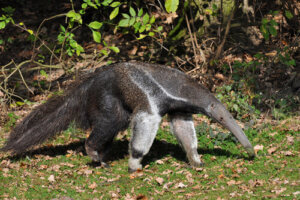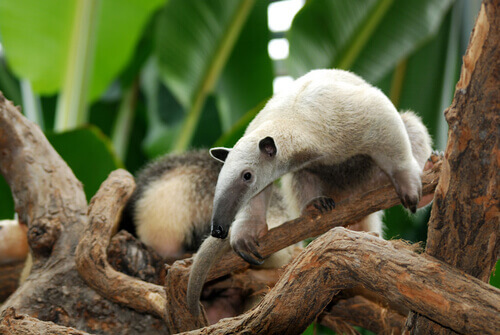The Characteristics and Behavior of the Anteater

This animal, known for its long snout and sticky tongue, lives in South and Central America. Its main food source is ants, which it catches more than efficiently. In this article, we’ll tell you all about the characteristics and behavior of the anteater.
Characteristics and feeding of the anteater
The anteater belongs to the placental mammal family and has a robust body -it can weigh 90 pounds and measure over 4 feet long. Its coat varies between different shades of gray, black, and beige. What’s more, its front legs are long and have strong, curved nails that allow it to climb trees or walk through vegetation.
The head of the anteater is small in comparison to the body and its long snout holds a tongue that can measure up to 2 feet long. It has no teeth but a great sense of smell, which allows it to find food.

Habitat and behavior of the anteater
The anteater lives in jungles, forests, grasslands, mountains, or savannas… Anywhere it can find ants or termites! It’s a passive, peaceful and quiet mammal that only attacks to defend itself when necessary. In this case, its technique consists of “embracing” danger and digging in its claws, in order to dissuade its predators. In that sense, its main predators are jaguars, pumas, and wolves.
The anteater’s an animal of solitary habits. In fact, it only joins with another member of its species when in heat or during the time that the baby remains next to its mother. Females have only one baby per litter after 190 days of gestation. From birth, the mother carries her baby on her back. The baby, in turn, grabs on with its claws and camouflages itself with its mother’s coat.

Anteater species
The general characteristics are the same among all anteaters. However, we can highlight four species, according to their location or size:
1. Giant anteater
This is the largest insectivore in the world. It has daytime habits and, at night, it returns to its cave to protect itself from the cold. It uses its sense of smell to find food, and once it finds it, uses its powerful claws to catch it.
The giant anteater moves with great speed in spite of its size and eats with a voracious appetite. It inserts its tongue up to 150 times per minute in an anthill. This technique is very effective and necessary to avoid ant stings. Unlike other species, the giant anteater doesn’t have a prehensile tail.
2. Silky anteater
It’s also known as a pygmy anteater and is the most difficult to find. This is due to its shyness and stealthiness while walking among the trees, from where it almost seldom descends. Its has a beige coat and a shorter face, feeds on larvae (besides ants), and isn’t very active. Its prehensile tail allows it to hang upside down from the branches and get food thanks to its long tongue.
3. Northern tamandua
The northern tamandua spends most of its life among forest trees, mangroves, and savannas. It rips termite mounds and ant hills from the ground and logs and slips its tongue between them to get food.
4. Southern tamandua
It’s also called ‘collared anteater’ because it has a lighter stripe of hair around the neck. It can live in jungles, savannahs and forests, as long as they have fresh water nearby.
We hope you’ve enjoyed learning all about the behavior of the anteater!
https://myanimals.com/es/oso-hormiguero-todas-las-caracteristicas-y-su-comportamiento/
This animal, known for its long snout and sticky tongue, lives in South and Central America. Its main food source is ants, which it catches more than efficiently. In this article, we’ll tell you all about the characteristics and behavior of the anteater.
Characteristics and feeding of the anteater
The anteater belongs to the placental mammal family and has a robust body -it can weigh 90 pounds and measure over 4 feet long. Its coat varies between different shades of gray, black, and beige. What’s more, its front legs are long and have strong, curved nails that allow it to climb trees or walk through vegetation.
The head of the anteater is small in comparison to the body and its long snout holds a tongue that can measure up to 2 feet long. It has no teeth but a great sense of smell, which allows it to find food.

Habitat and behavior of the anteater
The anteater lives in jungles, forests, grasslands, mountains, or savannas… Anywhere it can find ants or termites! It’s a passive, peaceful and quiet mammal that only attacks to defend itself when necessary. In this case, its technique consists of “embracing” danger and digging in its claws, in order to dissuade its predators. In that sense, its main predators are jaguars, pumas, and wolves.
The anteater’s an animal of solitary habits. In fact, it only joins with another member of its species when in heat or during the time that the baby remains next to its mother. Females have only one baby per litter after 190 days of gestation. From birth, the mother carries her baby on her back. The baby, in turn, grabs on with its claws and camouflages itself with its mother’s coat.

Anteater species
The general characteristics are the same among all anteaters. However, we can highlight four species, according to their location or size:
1. Giant anteater
This is the largest insectivore in the world. It has daytime habits and, at night, it returns to its cave to protect itself from the cold. It uses its sense of smell to find food, and once it finds it, uses its powerful claws to catch it.
The giant anteater moves with great speed in spite of its size and eats with a voracious appetite. It inserts its tongue up to 150 times per minute in an anthill. This technique is very effective and necessary to avoid ant stings. Unlike other species, the giant anteater doesn’t have a prehensile tail.
2. Silky anteater
It’s also known as a pygmy anteater and is the most difficult to find. This is due to its shyness and stealthiness while walking among the trees, from where it almost seldom descends. Its has a beige coat and a shorter face, feeds on larvae (besides ants), and isn’t very active. Its prehensile tail allows it to hang upside down from the branches and get food thanks to its long tongue.
3. Northern tamandua
The northern tamandua spends most of its life among forest trees, mangroves, and savannas. It rips termite mounds and ant hills from the ground and logs and slips its tongue between them to get food.
4. Southern tamandua
It’s also called ‘collared anteater’ because it has a lighter stripe of hair around the neck. It can live in jungles, savannahs and forests, as long as they have fresh water nearby.
We hope you’ve enjoyed learning all about the behavior of the anteater!
https://myanimals.com/es/oso-hormiguero-todas-las-caracteristicas-y-su-comportamiento/
All cited sources were thoroughly reviewed by our team to ensure their quality, reliability, currency, and validity. The bibliography of this article was considered reliable and of academic or scientific accuracy.
- Aguiar, L. M. S., & Petrazzini, P. B. (2021). You say goodbye, and I say hello: the giant anteater (Myrmecophaga tridactyla) activity pattern in response to temperature and human presence. Mastozoología Neotropical, 28(1), 469. https://www.redalyc.org/journal/457/45768739005/
- Allard, S. M., Earles, J. L., & DesFosses, L. (2014). Spatial memory in captive giant anteaters. Animal Behaviour and Cognition, 1, 331-340. https://doaj.org/article/e1d9a939e52b470cbed0f9196fab2834
- Buitrago, X. N., Pacheco, R. M., & Bolaño, C. R. (2019). Fisiología y hematología de osos hormigueros gigantes en cautiverio (Myrmecophaga tridactyla. Linnaeus, 1758), en Colombia. Revista Sistemas de Producción Agroecológicos, 10(1), 48-66. https://revistas.unillanos.edu.co/index.php/sistemasagroecologicos/article/view/724
- Gallo, J. A., Abba, A. M., Elizalde, L., Di Nucci, D., Ríos, T. A., & Ezquiaga, M. C. (2017). First study on food habits of anteaters, Myrmecophaga tridactyla and Tamandua tetradactyla, at the southern limit of their distribution. Mammalia, 81(6), 601-604. https://www.degruyter.com/document/doi/10.1515/mammalia-2016-0117/html?lang=de
- Gamboa, Sara. (2015). Origen de la mirmecofagia en mamíferos cenozoicos. Current Trends in Paleontology and Evolution. https://www.researchgate.net/publication/275890697_Origen_de_la_mirmecofagia_en_mamiferos_cenozoicos_The_origin_of_myrmecophagy_in_cenozoic_mammals
- Gaudin, T. J., Hicks, P., & Di Blanco, Y. (2018). Myrmecophaga tridactyla (Pilosa: Myrmecophagidae). Mammalian Species, 50(956), 1-13. https://academic.oup.com/mspecies/article/50/956/1/4968042?login=false
- Haddad Jr, V., Reckziegel, G. C., Neto, D. G., & Pimentel, F. L. (2014). Human death caused by a giant anteater (Myrmecophaga tridactyla) in Brazil. Wilderness & Environmental Medicine, 25(4), 446-449. https://pubmed.ncbi.nlm.nih.gov/25027752/
- Integrated Taxonomic Information System. (2019). Vermilingua Illiger, 1811. Recuperado el 29 de abril de 2023. https://www.itis.gov/servlet/SingleRpt/SingleRpt?search_topic=TSN&anchorLocation=SubordinateTaxa&credibilitySort=TWG%20standards%20met&rankName=Species&search_value=727504&print_version=SCR&source=from_print#SubordinateTaxa
- International Union for Conservation of Nature and Natural Resources. (2022) Search for Anteater. Recuperado el 27 de enero de 2022. https://www.iucnredlist.org/search?permalink=9fa1c682-4f50-40e2-85cd-79e697ddcec6
- La Procuraduría Federal de Protección al Ambiente. (2015). Rescata PROFEPA a oso hormiguero que deambulaba en zona habitacional de tabasco. Recuperado el 27 de enero de 2022. https://www.profepa.gob.mx/innovaportal/v/7025/1/mx.wap/rescata_profepa_a_oso_hormiguero_que_deambulaba_en_zona_habitacional_de_tabasco
- Miranda, F. R., Casali, D. M., Perini, F. A., Machado, F. A., & Santos, F. R. (2018). Taxonomic review of the genus Cyclopes Gray, 1821 (Xenarthra: Pilosa), with the revalidation and description of new species. Zoological Journal of the Linnean Society, 183(3), 687-721. https://academic.oup.com/zoolinnean/article/183/3/687/4716749
- World Wildlife Fund. (2023). El oso hormiguero más pequeño del mundo no tiene miedo a pelear. Recuperado el 29 de abril de 2023 https://www.worldwildlife.org/descubre-wwf/historias/el-oso-hormiguero-mas-pequeno-del-mundo-no-tiene-miedo-a-pelear
- Zoológico de Barcelona. (s.f.). Oso hormiguero: Myrmecophaga tridactyla. Zoo Barcelona. Recuperado el 7 de mayo del 2023. https://www.zoobarcelona.cat/es/animales/oso-hormiguero
- National Geographic. (s.f.). Giant anteater. Recuperado el 7 de mayo del 2023. https://www.nationalgeographic.com/animals/mammals/facts/giant-anteater
This text is provided for informational purposes only and does not replace consultation with a professional. If in doubt, consult your specialist.








